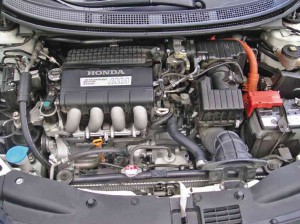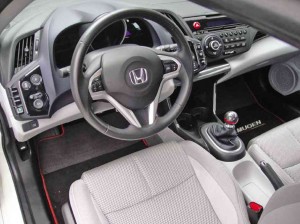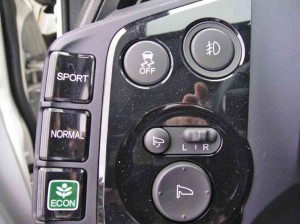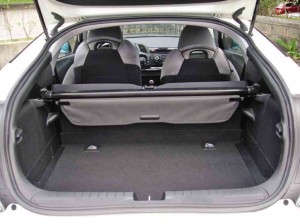Honda’s hybrid wannabe sports car
Equipped with a Mugen front grille, a Mugen wing-type rear spoiler and Mugen 17-inch racing wheels, the Honda CR-Z 3-door hatchback can easily be mistaken for just another showoff, gas-guzzling sports car. But wait! Underneath the enormous “CR-Z” letters painted in black on the doors are the words: “Hybrid Advanced Sports.”
Those three words make all the difference. You soon find out their meaning after driving the car: that the CR-Z is a green car wanting to be a sports car. This CR-Z is a 2011-2012 hybrid concept car that looks like a sports car and handles like one, but does not have the power of one. Its 1.5-liter i-VTEC 4-cylinder, 16-valve SOHC engine combines with a 10-Kw electric motor in Honda’s Integrated Motor Assist (IMA) hybrid system to produce a total of 122 bhp and 128 lb-ft of torque. Those aren’t exactly scorching numbers.
Introduced as a concept car at the 2007 Tokyo Motor Show, the CR-Z (Compact Renaissance Zero) is seen as the spiritual successor of the popular sporty CR-X (1984-1991). With the CR-Z, Honda Motor Company sought to create a sports car that is fun to drive but sips fuel frugally and leaves zero or minimal impact on the environment. In other words, Honda conceptualized the CR-Z as a car that would satisfy both the enthusiasts and the gas misers.
Has Honda succeeded? The jury is still out on that one. The first CR-Z, which was introduced in 2011 and the 2012 model of which I test-drove, is less of a focused driver’s car than, say, a basic Mini Cooper and drinks about the same amount of gasoline (average 13/15 km per liter in the MT or manual transmission model) as, say, a 1.3-liter MT Toyota Vios. Less advanced than Toyota’s Hybrid Synergy Drive, Honda’s IMA is a mild hybrid system that cannot operate the CR-Z on pure electric power. Aside from electric assist, the CR-Z conserves fuel with a start-stop system and regenerative brakes.
ENTERTAINING. But the CR-Z, aside from looking sportier, is more entertaining to drive due to its firm suspension (Mugen MacPherson strut front suspension and Mugen torsion beam rear suspension in the concept Mugen test unit I drove) and electronic power steering giving adequate feedback. Although the CR-Z is heavier than the Jazz at 2,700 lbs and you can feel the weight from behind the wheel, it’s still more fun to drive.
Credit that to its 6-speed short-throw stick shift. The CR-Z is the only hybrid car in the world that has a manual tranny. The MT is precise and quick in shifting gears together with good throttle feedback and a linear clutch action. The Mugen full bucket driver’s seat, small-diameter leather-wrapped steering wheel, Mugen carbon shift knob and futuristic cockpit controls canted to the driver enhance the sports car feeling. Not to mention the invigorating engine growl coming from the Mugen sports-finished exhaust pipe.
Mugen, if you don’t know it yet, is an engine tuner and parts manufacturer in Japan closely associated with, but not owned by, Honda Motor Co. Founded in 1973, Mugen tunes and races Honda vehicles in the Super GT championship and sells aftermarket parts to amateur enthusiasts, such as body kits for Honda cars.
Aside from the aforementioned Mugen parts and accessories, the test unit has Mugen front, side and rear under-spoilers, Mugen rear fog lights and Mugen power side mirrors with signal lights. All these Mugen add-ons make the CR-Z look infinitely snazzier, earning curious if not admiring glances.
MODES. Meanwhile, the 2011-2012 CR-Z offers three driving modes via buttons on the dash at the left of the steering wheel: Sport, Normal and Econ. Sport mode tightens the steering and improves throttle sensitivity while the electric motor provides more assistance to the gas engine. In Econ mode, throttle response is dulled, power and torque are reduced and the air-con fan speed is turned down to minimize compressor use. For pleasant motoring, select the Normal mode rather than Econ, which makes the car so sluggish you might fall asleep. The Sport mode is the best and most engaging, of course, but at the price of higher fuel consumption.
In other markets, the CR-Z is also available with a Continuously Variable Transmission (CVT). But the consensus is that the 6-speed MT CR-Z delivers driving joy and immediacy while the CVT model does not.

THE 1.5-LITER i-VTEC 4 cylinder engine with Integrated Motor Assist (IMA) hybrid system. PHOTOS BY AIDA SEVILLA-MENDOZA
Inside, the CR-Z is kitted with enough gizmos to keep high-tech infotainment addicts happy: Multiplier Meter instrument cluster, module-type single CD in-dash with MP3 and WMA playback, USB connection and AUX jack, 4 speakers and 2 tweeters, speed-sensitive audio, steering wheel-mounted audio controls, auto climate control, Econ button. Your safety is assured by six front and side airbags, Vehicle Stability Assist, ABS with EBD and brake assist, disc brakes front and rear, front passenger Occupant Position Detection System (OPDS) and high intensity discharge (HID) headlights.
The short, wedge-like shape, long front overhang, split glass rear hatch and triangular taillights are apparently standing the test of time since the second generation CR-Z retains these design features. The good news about the 2013 CR-Z that was unveiled at the Paris Auto Show last autumn is that output has been increased to 130 bhp and max torque from 123 lb-ft to 140 lb-ft.
Still not enough power? Watch out for the 2013 CR-Z Mugen RZ that packs over 170 bhp and 194 lb-ft max torque, thanks to a supercharger. Unfortunately, only 300 RZ units will be produced and all these will be sold in Japan. Over here, Honda Cars Philippines, Inc. isn’t offering the CR-Z yet pending the signing into law of the Alternative Fuel Vehicles Incentive Act. Until then, owning a 2013 Honda hybrid wannabe sports car will have to wait.





